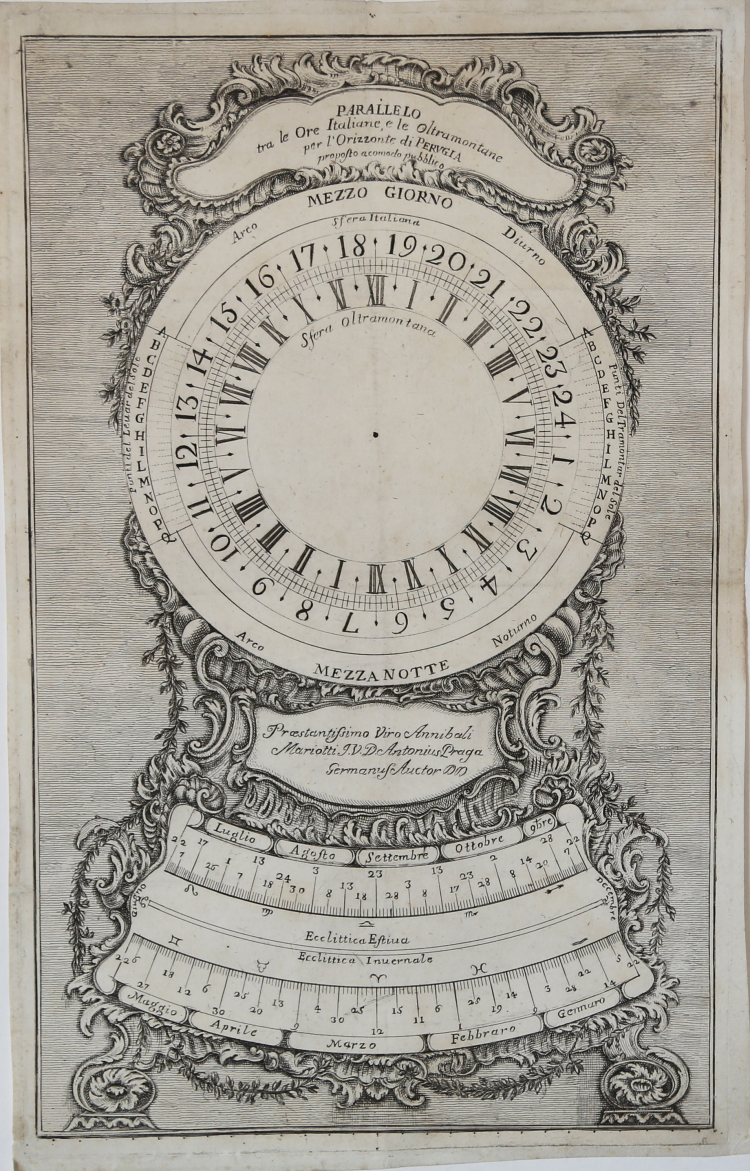



| Reference: | S42509 |
| Author | Antonio Praga |
| Year: | 1780 ca. |
| Zone: | Solar watch |
| Measures: | 300 x 750 mm |


| Reference: | S42509 |
| Author | Antonio Praga |
| Year: | 1780 ca. |
| Zone: | Solar watch |
| Measures: | 300 x 750 mm |
Etching and engraving, circa 1780-90 (?), signed and dedicated at bottom center: Praesstantissimo Viro Annibali Mariotti J. V. D. Antonius Praga Germanus Auctor DD. Printed on contemporary laid paper with “lily” watermark, with margins, in excellent condition.
Representation of a solar watch, with the comparison between the Italian time and the French time at the meridian of Perugia.
We have not found any notice about Antonio Praga "Germanus", while Annibale Mariotti (1738-1801) was a doctor and man of letters of liberal ideas from Perugia, arrested for not having retracted his support to the French, arrived in the city in 1797.
The Italic hour, also called Bohemian hour, is a method of subdivision of the day spread from the 14th century mainly in Italy (but also in Bohemia, Silesia and Poland), a method according to which the day was divided into 24 hours of the same duration, which were numbered from half an hour after sunset (when the bells rang the Ave Maria). This moment thus represented the twenty-fourth hour.
The main advantage of this method was that it made it easy to calculate the remaining hours of light, since it was sufficient to subtract from 24 the hour typically indicated by the number of chimes of the nearest bell tower. The main drawback of this system was instead that, since the time of sunset changes during the year, the same time of day was identified with different hours to vary the seasons: for example, noon (the time that divides in half the time interval between sunrise and sunset) corresponded approximately with the nineteenth hour in winter and with the sixteenth hour in summer. Moreover, the length of the hours was not constant, varying the distance of two successive sunsets by a few minutes each day, more or less depending on the time of year.
This method of calculating time was gradually supplanted after the middle of the eighteenth century by the so-called French or ultramontane hour, still used today, which defines the twelve o'clock (noon) the moment of the day when the sun is at its highest point. The adoption of this method was favored by the spread of mechanical clocks, which to be adjusted on the Italian time required continuous adjustments that, given the rudimentary technique of the time, caused problems of maintenance of the mechanisms. The transition was then definitively sanctioned with the Napoleonic domination of the Italian peninsula.
On the basis of this information we have dated this rare sheet to the end of the eighteenth century.
Antonio Praga
Antonio Praga